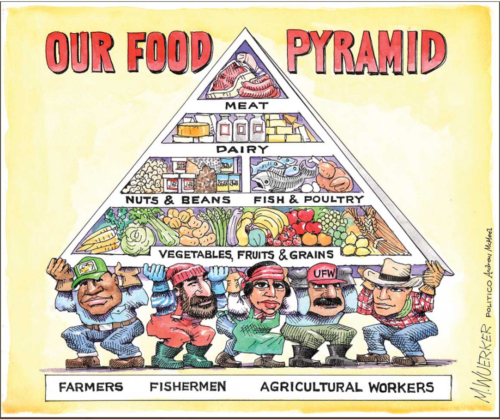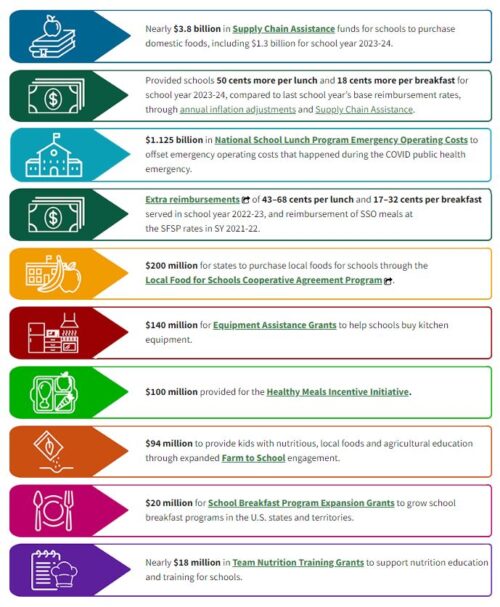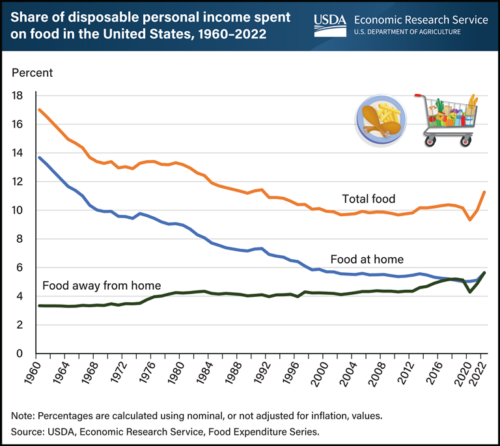Labor Day: an ever-timely food politics reminder

Enjoy the holiday!


I just bought a copy of this book, mainly because I like reading everything Cliff Wright writes. One of his previous books about Italian Cooking, A Mediterranean Feast, won two James Beard awards in 2000, one of them Cookbook of the Year, deservedly.
This one is a doorstop at 1191 pages and 5.6 pounds.
But no need to be intimidated. The structure is quite straightforward.
The book takes each region of Italy, in alphabetical order from Abruzzo to Veneto, and takes those regions province by province to discuss and provide recipes for characteristic dishes.
Take Emilia-Romagna, for example. First comes a history of the region, a discussion of its cuisine and questions about them, followed by characteristic recipes from the region and discussions and recipes of each of the provinces, also in alphabetical order, from Bologna to Rimini.
Wright introduces the book with a summary of how the history of Italy has influenced its food. For example:
In terms of what people at in Italy in the last fifteen hundred years, there is so much for which one must account, from the diffusion of Islamic agriculture between the seventh and twelfth centuries; the Black Death of the fourteenth century; the transition of the world economy from feudalism to capitalism and the wealth created as a result of the trade in, mostly, food products; the discovery of the New World in the late fifteenth century and the introduction of its new foods in the following century; and the changes in the consciousness of people themselves due to the Renaissance, humanism, and the nascent stirrings of modern science. This is a complex story, and it all has to be told so we can appreciate why Italian food is what it is today.
Hence, 1200 pages.
Interspersed throughout the book are boxed discussions of fasciinating details. On eggplant parmesan from the Regional Cuisine of Campania, for example, he says (among other things):
Let us dig a little deeper here. The first mention of something resembling eggplant Parmesan is from the rhyming poem Il saporetto by Simone Prudenzani (1387-1440). Prudenzani was from Orvieto, and Il saporetto, while not a cookbook, is about food, where a dish mentioned refers to well-grated parmigiano cheese being stuffed inside (Dentro nel parmiscian ben gratusgiato)….I believe the version we know today, with its Parmesan cheese and tomato ragoût, first appears in print in Ippolito Cavalcanti’s Cucina teorico-practica, published in Naples in 1837….
The recipes come with similar dicussions.
You either love this kind of thing or not. I tend to be for it.
For that reason, I do have a quibble with the book. It does not come with an Index of anything except the recipes.
The scholarly apparatus is limited to brief endnotes, a lengthy bibliography of what he read for this (17 pages of small type), and an index of the recipes by category, and by region and province. But the recipes are only a fraction of what is in this book.
The lack of an index is a serious omission.
Wright self-published this tome.
Still, I’m glad to have it.
Now that Barbie is a feminist icon, I have to confess I have two of them in my NYU office.

At one point I must have owned three, because here is an illustration from my book, Food Politics, published in 2002.

The feet on the MacDonald’s Barbie are flat—she’s wearing sneakers, appropriately for a doll on her feet all day.
The Oreo purse is a nice touch.
I don’t know what happened to my Coca-Cola Barbie but the other two are still in their boxes.
Who knew?
I received an email from the USDA about what it is doing about school meals for the fall (and see ALSO at the end of this post).
It included links or attachments to resources.
This last one shows the money USDA has put into school meals since 2021.

This looks impressive. Let’s hope it does good.
ALSO
The Chef Ann Foundation, which teaches scratch-cooking in schools, is recruiting applicants for its Healthy School Food Pathway Fellowship. This is a 13-month training program. See messages and graphics. They are also hosting an explanatory webinar—tomorrow—for which you can register here.
The Farm Bill is behind schedule, no surprise. The reasons have to do with costs and politics.
While Congressional agriculture committees are fussing over it, we have time to see what’s at stake.
I. The Congressional Research Service thas a report—Expiration of the Farm Bill—on what will happen to existing programs if the bill is not passed or extended by September 30, when it expires. Short summary: it depends on whether the program is permanently or temporarily funded.
II. Agri-Pulse farm bill preview: Key issues and proposals for each title. Blessings on Philip Brasher, Steve Davies, Jacqui Fatka, Noah Wicks, and Bill Tomson for putting together thie best summary I’ve seen of this bill. For each Farm Bill title, they briefly explain:
III. Food-Fix’s summary of farm bill proposals: If you don’t subscribe to Helena Evich Bottemiller’s FoodFix newsletter, now is the time. She writes about food politics in Washington, DC and keeps up with things most people (like me) can’t. She recently summarized some of the more recent marker bills:
Tribal Access to Nutrition Assistance Act
Puerto Rico Nutrition Assistance Act
I don’t have the kind of mind that can keep track of this level of detail, and depend on others to do the heavy lifting.
Many thanks to them.
A reader, Emma Calvert, a Senior Food Policy Officerfor the European Union in Brussels, sent me “this article. She also pointed me to the article Food Navigator wrote about it: “Review hails health benefits of beer-gut alliance.”
Eager to find out what the “beer-gut alliance” might be, I went right to it.
The study: Beer-gut microbiome alliance: a discussion of beer-mediated immunomodulation via the gut microbiome.” Silu Zhang, Shuo Jin, Cui Zhang, Shumin Hu, Huajun Li. Front. Nutr., 25 July 2023. Volume 10. https://doi.org/10.3389/fnut.2023.1186927
Background: “As a long-established fermented beverage, beer is rich in many essential amino acids, vitamins, trace elements, and bioactive substances that are involved in the regulation of many human physiological functions. The polyphenols in the malt and hops of beer are also important active compounds that interact in both directions with the gut microbiome.”
Methods: “This review summarizes the mechanisms by which polyphenols, fiber, and other beneficial components of beer are fermentatively broken down by the intestinal microbiome to initiate the mucosal immune barrier and thus participate in immune regulation.”
Conclusion: “Beer degradation products have anti-inflammatory, anticoagulant, antioxidant, and glucolipid metabolism-modulating potential. ..The positive effects of bioactive substances in beer in cancer prevention, reduction of cardiovascular events, and modulation of metabolic syndrome make it one of the candidates for microecological modulators.”
Funding: “This study was supported by the Open Research Fund of State Key Laboratory of Biological Fermentation Engineering of Beer, under grant no. K202101.”
Conflict of interest: “CZ and SH were employed by Tsingtao Brewery Co. Ltd. The remaining authors declare that the research was conducted in the absence of any commercial or financial relationships that could be construed as a potential conflict of interest.”
Comment: This seems like a lot to claim for beer. Vested interest? Yes. The State Key Beer Lab is part of the Tsingtao Brewery Co. Ltd, Qingdao, 266100, China and two of the authors work for the company. Why do this study? To distract attention from the harmful effects of alcohol consumption (where do I begin?) and from its calories, and instead give beer a health aura.
Beer, alas, is not a health food, best consumed in moderation if at all.
Sorry.
One of the most viewed articles in The Guardian last week was this one on possible conflicts of interest among WHO panelists dealing with the health effects of the artificial sweetener, aspartame.
The headline: Revealed: WHO aspartame safety panel linked to alleged Coca-Cola front group
The article refers to the release last month of two somewhat contradictory reports on the potential carcinogenicity of the artificial sweetener, aspartame, a situation I referred to in this space as crazy-making.
To review:
A report from US Right to Know poses a possible explanation: “Did a Coca-Cola front group sway a WHO review of aspartame?”
One possible answer: at least six out of 13 JECFA panel members have ties to ILSI, a longtime Coca-Cola front group. [In addition] Both the chair and vice chair of the JECFA panel have ties to ILSI.
I’ve written repeatedly about ILSI actions on behalf of the food industry, most recently about how it tracked responses to my book Unsavory Truth (in which I discuss the organization as a front group).
Just because committee members have affiliations with an industry front group does not mean they cannot be objective about the science of aspartame, and I have certainly heard arguments that anyone who has any stature in nutrition cannot avoid such ties (full disclosure: in the late 1980s, ILSI attempted—unsuccessfully, no surprise—to recruit me for a job).
But it is striking that 8 of 13 members had such an affiliation, a (perhaps) coincidence that got The Guardian’s attention.
At the very least, the membership gives the appearance of a conflict of interest, which is one reason why such things matter.
USDA’s Economic Research Service reports on trends in food consumption, with enlightening charts. I thought this one was worth a close look.

The chart shows the proportion of income spent for total food—roughly 11% in 2022, a level last reached in 1991. Food costs are going up—a lot.
The proportions spent inside and outside the home are roughly the same.
The drop in away-from-home eating in 2020 and 2021 was due to pandemic, restrictions of course, but is now recovering.
The decline in at-home eating is a long-term trend, reflecting major changes in American society.
The rise in away-from-home eating has health implications.
Away-from-home meals:
Bring back home economics?